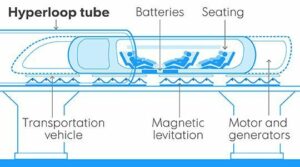Hyperloop is a new form of ground transport currently in development by a number of companies, It could see passengers travelling at over 700 miles an hour in floating pods which race along inside giant low-pressure tubes, either above or below ground.
Features of Hyperloop
- The speed of conventional trains and all land based transport is limited by friction, both against the air ahead and the ground beneath. Hyperloop drastically reduces friction in both of these areas.
- The pods carrying passengers travel through tubes or tunnels from which most of the air has been removed to reduce friction. This should allow the pods to travel at very high speeds.
- The hyperloop pods, each containing a handful of passengers are held above the ground by a layer of air, similar to how the puck of an air hockey table floats across its surface.
- Overcoming air resistance is one of the biggest uses of energy in high speed travel. Airliners climb to high altitudes to travel through less dense air; in order to create a similar effect at ground level, Hyperloop encloses the capsules in a reduced-pressure tube.
- The pod would get its initial velocity from an external electric motor, which would accelerate it to ‘high subsonic velocity’ and then give it a boost every 70 miles or so; in between, the pod would coast along in near vacuum.
- It is lower cost and more energy efficient because the track doesn’t need to provide power to the pods continuously and the pods can leave every 30 seconds, it’s more like an on-demand service.

















